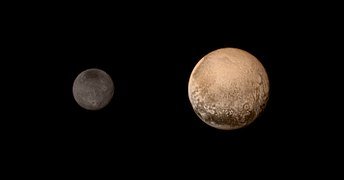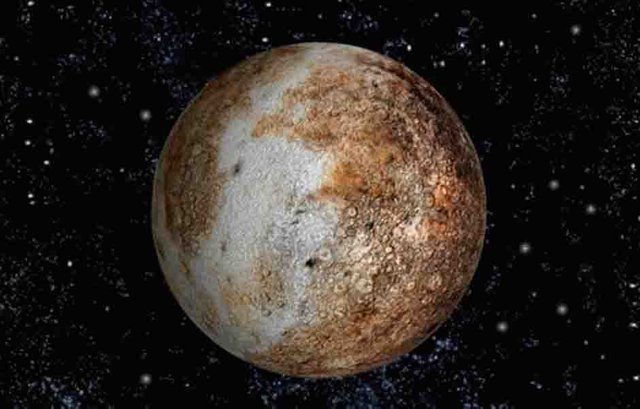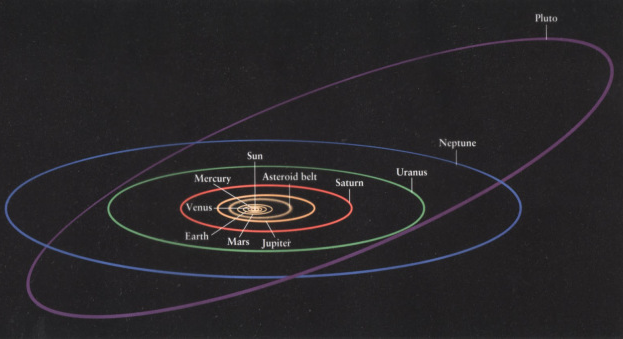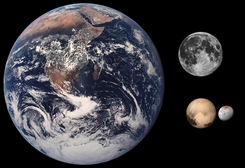Pluto - Dwarf planet
Pluto, provisional designation: 134340 Pluto, is a dwarf planet of the solar system located next to the orbit of Neptune. Its name is due to the mythological Roman god Pluto (Hades according to the Greeks). At the General Assembly of the International Astronomical Union (UAI) held in Prague on August 24, 2006, a new category called plutoid was created, which includes Pluto. It is also the prototype of a category of transneptunian objects called plutinos. It has an eccentric orbit and very inclined with respect to the ecliptic, which runs close to its perihelion in the orbit of Neptune. Because of its density, Pluto seems made of rock, nitrogen, methane and carbon monoxide that freeze and fall on the surface as it moves away from the sun. Instead, the satellite is much lighter. This difference suggests that they were formed separately and then joined together.
Its great distance to the Sun and the Earth, together with its small size, prevents it from shining above the magnitude of 13.8 at its best moments (orbital perihelion and opposition), so it can only be seen with 200 mm telescopes.
Has five satellites: Charon, Nix, Hydra, Cerberus and Stygia.3 4 These are celestial bodies that share the same category.
Pluto was discovered on February 18, 1930 by the American astronomer Clyde William Tombaugh (1906-1997) of the Lowell Observatory in Flagstaff, Arizona, and was considered the ninth and smallest planet in the solar system by the International Astronomical Union and by the public. opinion from then until 2006, although its belonging to the group of planets of the solar system was always subject to controversy among astronomers. Even for many years there was a belief that Pluto was a satellite of Neptune that had ceased to be a satellite because it reached a second cosmic speed. However, this theory was rejected in the 1970.
Dwarf Planet
The debate arrived on August 24, 2006 with a resolution of the UAI in which established the official definition of planet. According to her, there are three conditions for an object to be considered a planet:
• The object must be in orbit around the Sun.
• The object must be massive enough so that its gravity has rounded it. More specifically, its own gravity must bring it to hydrostatic equilibrium.
• The object must have cleared the vicinity of its orbit. Pluto does not fulfill the third condition because its mass is only 0.07 times the mass of the other objects in its orbit -
in comparison, the mass of the Earth is 1.7 million times that of its orbital region - so the AUI also decided that The bodies that meet only the first two criteria would be called "dwarf planets".
Pluto's Orbit
Is very eccentric and, for 20 of the 248 years it takes to travel, it is closer to the Sun than Neptune. It is also much more inclined to the plane of the ecliptic than any of the planets of the solar system, with its inclination of 16 °, so there is no danger of collision with Neptune. When the orbits cross they do so near the ends so that, in a direction perpendicular to the ecliptic, they are separated by a huge distance. Pluto reached its perihelion for the last time in September 1989 and continued to move within Neptune's orbit until March 1999. It is currently moving away from the Sun and will not be closer to the Sun than Neptune until September 2226.
What is the difference between a planet and a dwarf planet?
A dwarf planet and a planet are practically equal, but the difference between one and another, according to the International Astronomical Union, is that a dwarf planet does not have orbital dominion and shares space with other celestial bodies; However, although this definition is accepted, astronomers are still discussing this term.
Pluto's little companions
In addition to Pluto, there are other dwarf planets in the solar system that do not meet the new definition proposed by the International Astronomical Union of the planet: Haumea, Sedna, Makemake, Eris and Ceres. All these dwarf planets were discovered in the 21st century, with the exception of Ceres, which was discovered in the 19th century by Giuseppe Piazzi from an observatory in Palermo, Italy.
Ceres is the largest astronomical object in the Asteroid Belt, a region of space between the orbits of Mars and Jupiter, and is the only dwarf planet whose trajectory lies within the orbit of Neptune.
http://www.ngenespanol.com/ciencia/el-espacio/17/08/24/porque-pluton-dejo-de-ser-planeta/








You received a 10.0% upvote since you are not yet a member of geopolis.
To read more about us and what we do, click here.
https://steemit.com/geopolis/@geopolis/geopolis-the-community-for-global-sciences-update-2-higher-base-votes-new-logo
If you do not want us to upvote and comment on your posts concerning earth and earth sciences, please reply stop to this comment and we will no longer bother you with our love ❤️